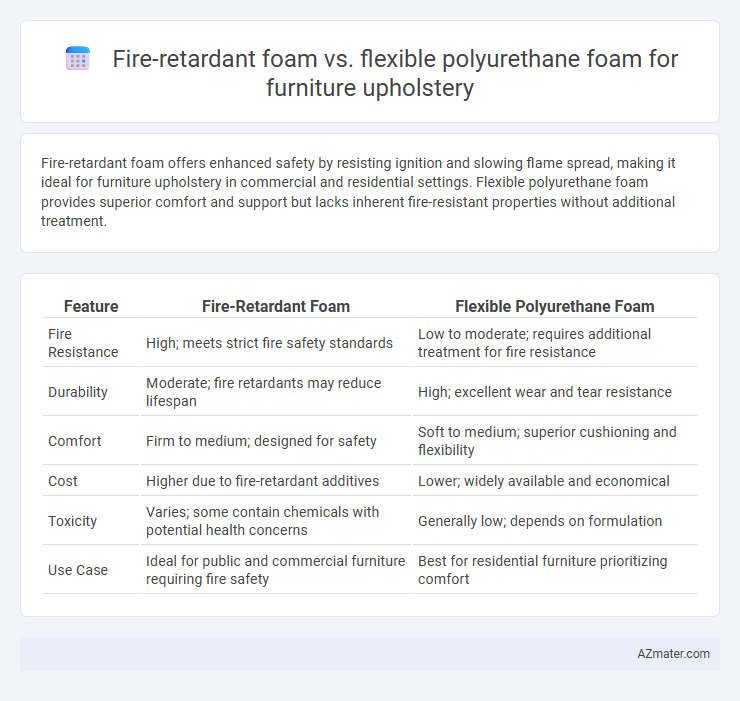Fire-retardant foam offers enhanced safety by resisting ignition and slowing flame spread, making it ideal for furniture upholstery in commercial and residential settings. Flexible polyurethane foam provides superior comfort and support but lacks inherent fire-resistant properties without additional treatment.
Table of Comparison
| Feature | Fire-Retardant Foam | Flexible Polyurethane Foam |
|---|---|---|
| Fire Resistance | High; meets strict fire safety standards | Low to moderate; requires additional treatment for fire resistance |
| Durability | Moderate; fire retardants may reduce lifespan | High; excellent wear and tear resistance |
| Comfort | Firm to medium; designed for safety | Soft to medium; superior cushioning and flexibility |
| Cost | Higher due to fire-retardant additives | Lower; widely available and economical |
| Toxicity | Varies; some contain chemicals with potential health concerns | Generally low; depends on formulation |
| Use Case | Ideal for public and commercial furniture requiring fire safety | Best for residential furniture prioritizing comfort |
Introduction to Upholstery Foam Options
Fire-retardant foam and flexible polyurethane foam serve distinct roles in furniture upholstery, offering different benefits based on safety and comfort requirements. Fire-retardant foam is designed to meet strict flammability standards, making it ideal for public spaces and commercial furniture where fire safety regulations apply. Flexible polyurethane foam provides superior cushioning and resilience, enhancing ergonomic comfort in residential and custom upholstery projects without inherently meeting fire resistance criteria.
What is Fire-Retardant Foam?
Fire-retardant foam is a type of upholstery material treated with chemical additives to resist ignition and slow the spread of flames, making it compliant with stringent fire safety standards such as California TB117-2013 or the UK's BS 5852. Unlike flexible polyurethane foam, which is highly flammable and commonly used for comfort, fire-retardant foam incorporates flame-retardant barriers or inherently fire-resistant compounds to enhance safety in furniture applications. This specialized foam is essential in public and commercial spaces where fire regulations demand materials that reduce fire hazards without compromising cushioning performance.
Understanding Flexible Polyurethane Foam
Flexible polyurethane foam, widely used in furniture upholstery, offers superior cushioning and durability, making it ideal for seating applications. Fire-retardant foam incorporates chemical additives to meet stringent fire safety standards without compromising comfort, but may have a slightly different texture and resilience. Understanding the balance between comfort, safety regulations such as California TB117-2013, and material properties is crucial for selecting the appropriate foam for upholstered furniture.
Key Differences in Material Composition
Fire-retardant foam for furniture upholstery contains chemical additives such as brominated or phosphate-based compounds designed to reduce flammability and slow ignition. Flexible polyurethane foam, commonly used for comfort and cushioning, primarily consists of polyols and isocyanates formed through a polymerization process without inherent fire-resistant properties. The presence of fire-retardant chemicals in the foam formulation significantly affects the foam's thermal stability, burning rate, and safety standards compliance compared to standard flexible polyurethane foam.
Fire Safety Standards and Compliance
Fire-retardant foam used in furniture upholstery is engineered to meet stringent fire safety standards such as CAL TB117-2013 and BS 5852, significantly reducing flammability and smoke generation compared to flexible polyurethane foam. Flexible polyurethane foam, while widely used for comfort, typically requires treatment with fire retardants to comply with regulatory fire safety codes, which can affect its durability and chemical profile. Compliance with fire safety regulations ensures that upholstery materials minimize fire hazards, making fire-retardant foams the preferred choice in commercial and residential settings demanding higher safety performance.
Comfort and Support Comparison
Fire-retardant foam for furniture upholstery offers enhanced safety by resisting ignition while maintaining moderate comfort and support, suitable for compliance with strict fire codes. Flexible polyurethane foam excels in providing superior cushioning, contouring closely to body shape, which results in higher comfort and pressure relief but may lack inherent fire resistance without treatment. Choosing between these foams depends on balancing the need for comfort and ergonomic support against fire safety requirements in upholstery applications.
Durability and Longevity of Each Foam
Fire-retardant foam offers enhanced protection against flame ignition but typically exhibits lower durability and faster degradation under frequent use compared to flexible polyurethane foam. Flexible polyurethane foam is widely favored in furniture upholstery due to its superior resilience, ability to maintain shape, and longer lifespan under regular stress and compression. Selecting foam with higher density and ILD (Indentation Load Deflection) ratings can further improve durability and prolong the furniture's functional life.
Environmental Impact and Sustainability
Fire-retardant foam often contains chemical additives such as halogenated flame retardants, which raise concerns about toxicity and long-term environmental persistence, causing challenges in recycling and disposal. Flexible polyurethane foam, while more versatile and widely used, is typically petroleum-based and contributes to carbon emissions during production, but innovations in bio-based polyols and more sustainable formulations are reducing its environmental footprint. Choosing foams with third-party eco-certifications and those designed for recyclability can significantly improve sustainability profiles in furniture upholstery applications.
Cost Considerations for Upholstery Projects
Fire-retardant foam for furniture upholstery typically costs 30-50% more than standard flexible polyurethane foam due to specialized fire-resistant chemicals and compliance with safety regulations. Flexible polyurethane foam remains a cost-effective choice for budget-conscious projects but may require additional treatments or barriers to meet fire safety standards. Budget planning for upholstery projects should weigh the higher upfront cost of fire-retardant foam against potential regulatory compliance and insurance savings over time.
Choosing the Right Foam for Furniture Upholstery
Fire-retardant foam offers critical safety benefits by complying with stringent flammability standards, making it ideal for environments requiring enhanced fire resistance. Flexible polyurethane foam provides superior comfort and durability due to its resilience and cushioning properties, making it a popular choice for residential furniture. Selecting the right foam depends on balancing safety regulations and comfort demands, ensuring both protection and long-lasting upholstery performance.

Infographic: Fire-retardant foam vs Flexible polyurethane foam for Furniture upholstery
 azmater.com
azmater.com